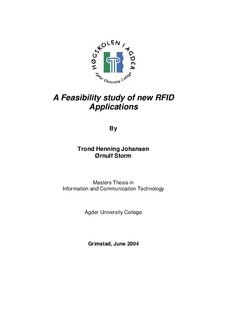| dc.description.abstract | The introduction of Radio Frequency Identification represented quite a revolution to the
various areas of industry and business, focusing on the process of marking items for
automatic identification. RFID offers similar functionality as the well established
barcode, but with major additional advantages. These are in short read/write capability,
memory, and operation independent of free line of sight between reader and tag.
Enhanced production techniques also seems to contribute to lower production cost and
thus cost per unit boosting the research on new and promising RFID applications.
Other factors contributing to the adoption of RFID technology is the tendency of
multinational companies as Hewlet Packard and Microsoft to join the global initiative of
RFID standardisation. EPCglobal was launched by an European, American and Asian
initiative lead by respectively EAN International and UCC. Another matter is the fact that
widespread use of ISM frequecies simplifies the role of national legislation Finally the
issues of ethics and privacy are to be adressed as this is about to be a major problem
regarding RFID technology and thus a potential hurdle for further progress and comercial
success on a global basis.
In this report we focus on recent research projects, driven by features as integrated
sensors, memory, and processing capacity. Based on this we aim to call attention to a
limited number of promising applications which will be evaluated against a number of
criterias in a framework developed especially for this master thesis, adressing matters
such as frequency and range, active or passive transponders, memory requirements,
dependency of ongoing or future standardisation, radio regulation and privacy contraints.
We will also discuss external factors such as the influence of tag price and numbers of
items to be tagged in the applications. By discussing each of the chosen applications in
relation to the selected criterias we found which applications that appeared to be of
particular interest comercially and thus recommendable for actual implementation. We
have made the conclusion that several of the new promising RFID applications are ready
to be launched and would have potential good prospects for future use.
One major obstacle for sucessful implementation appears to be the privacy issue.
With this issue under control, launching a Supply Chain Managagement system as a
global reaplacement for the bar code system using tags stardardised by EPCglobal would
have very good prospects for being sucessful within a few years. Immediate
implementation would only be possible in small scale, but in late 2005 larger
implementations seems very likely, if standardisation of ECPglobal has settled. Also asset
tracking of important or valuable items as well as tracking of persons could have good
chances of looking at sucessful implementations in the near future as long as the privacy
issues are taken taken into careful consideration.
Due to the ongoing work on standardisation it seems like at small pilot would be
appropriate in order to reduce potential loss due to changing standards. This would
provide valuable experience in handeling the technology while awaiting the
standardisation, etichs and privacy issues to settle. Furthermore it seems that pilots
featuring passive technology would contribute to lowering the risk even further as the
marking of numerous items by active technology could imply rather high costs. | en |
